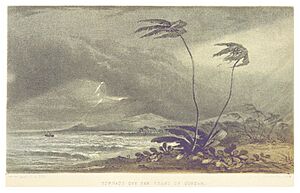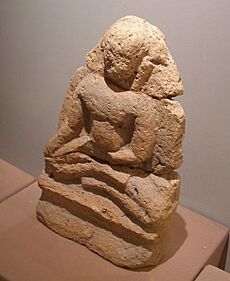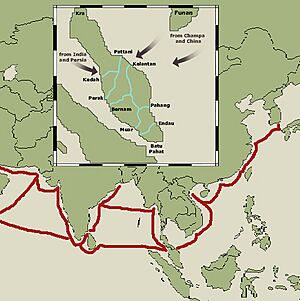History of Kedah facts for kids

Kedah is a state in Malaysia with a very long and interesting history! People first settled here around 1,000 years ago near the Merbok River. This early settlement, called Sungai Batu, was close to where the river met the sea. We know about Kedah's past from old archaeological sites like Bujang Valley, records from traders from India, Persia, and Arabia, and writings by early Chinese travelers. Later, stories like the Hikayat Merong Mahawangsa and Al-Tarikh Salasilah Negeri Kedah also tell us about its history.
Around 170 CE, groups of Hindu people arrived in Kedah. Soon after, people from nearby islands and the northern Mon-Khmer region joined them. Traders from India, Persia, and Arabia used Gunung Jerai (a mountain) as a landmark when sailing through the Malacca Strait.
After the 7th century, a powerful kingdom called Srivijaya took control of Kedah. Kedah was important for trade, selling tin and jungle products like rattan, honey, and ivory. It also made money from taxes. Kedah became an Islamic state in the 15th century (some say 1136 CE). It then came under the rule of the Malacca Sultanate and later the Ayutthaya Kingdom. In 1786, Kedah gave Penang to the British. In the 1820s, Siam invaded Kedah. Finally, Kedah was transferred to Britain in 1909 under the Anglo-Siamese Treaty of 1909. It remained part of British Malaya until Malaysia became independent in 1957.
Contents
Ancient History of Kedah
Early Settlers: Austronesians
About 3,500 years ago, people called Austronesians started moving into the South East Asia Archipelago. Many experts believe their original home was Taiwan. Around 4,000 years ago, some Austronesians moved to the Philippines. Later, their descendants traveled south to what is now Indonesia and east to the Pacific islands.
Austronesians were amazing sailors. They explored and settled lands as far away as New Zealand, Hawaii, and Madagascar. In some places, they married local people, like the Orang Asli, and became known as Deutero-Malays. Perhaps as early as 400 BCE, Austronesians began sailing west. They were looking for new places to trade their goods.
Early Trade and Ships
In the 1st century CE, some Greco-Roman merchants wrote about huge, non-Indian ships. These ships came from the east with valuable cargo. They were likely from the Malay Archipelago. This shows that Malay people were active in the Indian Ocean trade. They probably handled much of the trade between Southeast Asia and India.
Writers from that time described three types of boats. There were small boats for local travel along the coast. Then, there were larger, more complex vessels that could carry more goods. Finally, there were very big ocean-going ships. These ships made long journeys to Malaya, Sumatra, and the Ganges River.
Pre-Hindu Civilisation
Sungai Batu: An Ancient City
Deep in the Merbok River estuary, many old treasures have been found. Ancient ruins, buildings, temples, a harbor, and shipwrecks were buried in the ground for about 2,000 years. At its busiest, this settlement covered about 1,000 square kilometers. It was a very important place in the northern Malay Peninsula. Today, this area is known as the lost city of Sungai Batu. It was founded in 788 BCE. This makes it one of the oldest civilisations in Southeast Asia. It might even be the origin of the later Kedah Tua kingdom.
Iron Industry in Sungai Batu
The history of Sungai Batu is closely linked to its iron industry. Archaeologists have found old mines, warehouses, factories, and a harbor. They also found many high-quality ores, furnaces, slag (waste from smelting), and ingots (blocks of metal). The way they melted iron using a Tuyere (a pipe for air) in Sungai Batu is thought to be the oldest of its kind. The iron they produced was very popular. It was sent to many parts of the Old World, including ancient India, China, the Middle East, Korea, and Japan. Early Sanskrit writings called the area "the iron bowl" because of this.
Early Beliefs and Religions
The first people in the Malay Archipelago followed local beliefs. These included animism and shamanism. These beliefs were similar to other old religions in Eastern Asia, like Shinto. People believed that everything in nature had a spirit, called semangat. They thought these spirits could bring good or bad luck. So, they always tried to please and entertain the spirits. In Sungai Batu, archaeologists found old buildings used for ceremonies and worship. These were likely for worshipping the sun and mountains.
Besides Sungai Batu, other large ancient cities also grew in the early Malay Archipelago. These cities had farming communities, skilled craftspeople, and many local and foreign traders. Chinese records mention names like Akola, P’an P’an, Tun-Sun, Chieh-ch'a, and Ch'ih-tu. By the 5th century CE, these settlements had become independent city-states. They were all part of a big international trade network. They also welcomed diplomats from China and India.
Pre-Islamic Period
Kedah and Srivijaya
Kedah eventually became part of the powerful Srivijaya kingdom. This led to conflicts with the Chola Empire from the 9th to 13th centuries CE. The Cholas had a strong merchant and naval fleet in the Indian Ocean and the Bay of Bengal. In the early 11th century, the Chola King Rajendra I sent an army to attack Kedah (which was part of Srivijaya). He did this to help one of Srivijaya's rulers who wanted to take the throne. The Chola fleets defeated Srivijaya. They captured and looted Kedah.
Hindu and Buddhist Influences
In ancient Kedah, there was an important Hindu settlement. This site was first reported in the 1840s by Colonel James Low. Later, Dr. Horace Wales studied over thirty sites around Kedah. His findings showed that people lived here for centuries. They were strongly influenced by South Indian, Buddhist, and Hindu cultures.
Kedah was located near the entrance to the Strait of Malacca. It was also close to the latitude south of India. This meant that ships sailing in the Bay of Bengal were less likely to get lost. Early traders from the west would arrive at the coast. Then, they would hire porters to carry goods by raft, elephant, or by walking. They would transport the goods along rivers to the other side of the Kra Isthmus.
Ancient Writings and Inscriptions
The Tamils from Southern India and the local Malays used a rounded writing style called Vatteluttu. This was different from the Devanagari script used in Northern India. Scholars like George Cœdès and D.G.E. Hall often called Vatteluttu the Pallava script. The Tamil script of Vatteluttu later developed into the Old Kawi script. This script was used in Java, the Philippines, and Bali.
Stone inscriptions show that the Kedah region was already a trade center by 400 CE or earlier. One old Malay text mentions a king named Ramaunibham. He might be the first local ruler whose name is recorded in history. This period shows how Indian cultures influenced the region. In return, the local people taught Indians about living skills on the sea and in the hills.
An inscribed stone bar was found in Kedah. It has the Ye Dharma Hetu saying in South Indian characters from the 4th century CE. This shows that the shrine near where it was found (site I) was Buddhist. Only the base of the shrine remains. Another inscription is on three sides in Pallava script or Vatteluttu rounded writing from the 6th century CE, or possibly earlier. One of the early inscription stones found by James Low, at Bukit Meriam and in Muda River, mentions Raktamrrtika. This word means ‘Red Earth’ (Tanah Merah).
Inscriptions in both Tamil and Sanskrit tell us about the activities of people and rulers from the Tamil country of South India. The Tamil inscriptions are at least four centuries older than the Sanskrit ones. This shows that early Tamils also supported the Sanskrit language.
A Sanskrit inscription from 1086 CE was found in Kedah. It was left by Kulottunga I of the Chola empire. It proves that there was trade between the Chola Empire and Malaya.
Modern History of Kedah
Islam Comes to Kedah
The At-Tarikh Salasilah Negeri Kedah says that the royal family of Kedah became Muslim in 1136 CE. However, historian Richard O. Winstedt thinks a more likely date for Islam to arrive is 1474. This date matches the Malay Annals. That book describes a raja (ruler) of Kedah visiting Malacca during the reign of its last sultan. The raja wanted the special royal band that showed a Malay Muslim ruler's power. Kedah asked for this because it wanted to be a vassal (a state under the protection of) of Malacca.
Changes in Power
Kedah later came under the rule of Siam. Then, the Malacca Sultanate conquered it in the 15th century. In the 17th century, Kedah was attacked by the Portuguese and also by the Aceh Sultanate. Later, in the late 18th century, Sultan Abdullah Mukarram Shah hoped Great Britain would protect Kedah from Siam. So, he agreed to give Penang to the British.
However, Siam still invaded Kedah in 1821. Kedah remained under Siamese control and was called Syburi. In 1896, Kedah, along with Perlis and Setul, became part of the Siamese province of Monthon Syburi. This lasted until it was given to the British by the Anglo-Siamese Treaty of 1909.
World War II and Independence
During World War II, Kedah (along with Kelantan) was the first part of Malaya to be invaded by Japan. The Japanese then gave Kedah to their Thai allies, who renamed it Syburi. But after the war ended, Kedah was returned to British rule. Kedah became one of the states of the Federation of Malaya in 1948. This federation then gained independence in 1957. Malaya later grew to become Malaysia in 1963.
See also
- Chi Tu
- Sultanate of Kedah
- Cities along the Silk Road




